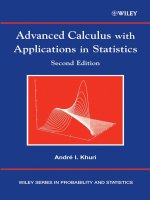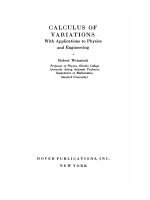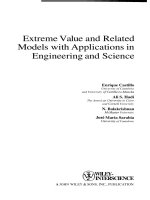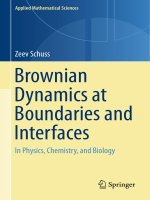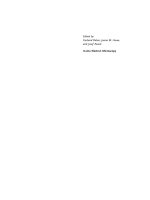Advanced calculus explored with applications in physics, chemistry
Bạn đang xem bản rút gọn của tài liệu. Xem và tải ngay bản đầy đủ của tài liệu tại đây (7.35 MB, 444 trang )
1
Advanced Calculus
Explored
With Applications in Physics,
Chemistry, and Beyond
2
ADVANCED CALCULUS
EXPLORED
WITH APPLICATIONS
IN
PHYSICS, CHEMISTRY, AND
BEYOND
Hamza E. Alsamraee
3
This page is intentionally left blank.
4
Copyright © 2019 by Hamza E. Alsamraee. All rights reserved. No
part of this book may be reproduced or distributed in any form,
stored in any data base or retrieval system, or transmitted in any
form by any means—electronic, mechanical, photocopy, recording, or otherwise—without prior written permission of the publisher, except as provided by United States of America copyright
law. For permission requests, e-mail the publisher at curiousmath.
First edition published November 2019
Book cover design by Ayan Rasulova
Typeset using LATEX
Printed on acid-free paper
ISBN 978-0-578-61682-7
www.instagram.com/daily_math_/
5
To my parents.
6
To numerically confirm the many evaluations and results
throughout this book, various integration and summation commands available in software produced by Wolfram Research, Inc. were utilized. Moreover, virtually all
illustrations and graphs were produced by software produced by Wolfram Research, unless specified otherwise.
Specifically, Wolfram Desktop Version 12.0.0.0 running
on a Windows 10 PC. As of the time of the release of
the book, this is the latest release of Wolfram Desktop.
The commands in this book are standard and are likely
to continue to work for subsequent versions. Wolfram
Research does not warrant the accuracy of the results
in this book. This book’s use of Wolfram Research software does not constitute an endorsement or sponsorship
by Wolfram Research, Inc. of a particular pedagogical
approach or particular use of the Wolfram Research software.
Contents
About the Author
15
Preface
23
I
27
Introductory Chapters
1 Differential Calculus
1.1
1.2
1.3
29
The Limit . . . . . . . . . . . . . . . . . . . . . . . . .
30
1.1.1
L’Hopital’s Rule . . . . . . . . . . . . . . . . .
36
1.1.2
More Advanced Limits . . . . . . . . . . . . . .
40
The Derivative . . . . . . . . . . . . . . . . . . . . . .
45
1.2.1
Product Rule . . . . . . . . . . . . . . . . . . .
46
1.2.2
Quotient Rule . . . . . . . . . . . . . . . . . . .
48
1.2.3
Chain Rule . . . . . . . . . . . . . . . . . . . .
49
Exercise Problems . . . . . . . . . . . . . . . . . . . .
56
7
8
CONTENTS
2 Basic Integration
59
2.1
Riemann Integral . . . . . . . . . . . . . . . . . . . . .
60
2.2
Lebesgue Integral . . . . . . . . . . . . . . . . . . . . .
63
2.3
The u-substitution . . . . . . . . . . . . . . . . . . . .
65
2.4
Other Problems . . . . . . . . . . . . . . . . . . . . . .
82
2.5
Exercise Problems . . . . . . . . . . . . . . . . . . . .
99
3 Feynman’s Trick
101
3.1
Introduction . . . . . . . . . . . . . . . . . . . . . . . . 102
3.2
Direct Approach . . . . . . . . . . . . . . . . . . . . . 103
3.3
Indirect Approach . . . . . . . . . . . . . . . . . . . . 128
3.4
Exercise Problems . . . . . . . . . . . . . . . . . . . . 131
4 Sums of Simple Series
135
4.1
Introduction . . . . . . . . . . . . . . . . . . . . . . . . 136
4.2
Arithmetic and Geometric Series . . . . . . . . . . . . 136
4.3
Arithmetic-Geometric Series . . . . . . . . . . . . . . . 141
4.4
Summation by Parts . . . . . . . . . . . . . . . . . . . 146
4.5
Telescoping Series . . . . . . . . . . . . . . . . . . . . . 152
4.6
Trigonometric Series . . . . . . . . . . . . . . . . . . . 159
4.7
Exercise Problems . . . . . . . . . . . . . . . . . . . . 163
9
CONTENTS
II
Series and Calculus
5 Prerequisites
165
167
5.1
Introduction . . . . . . . . . . . . . . . . . . . . . . . . 168
5.2
Ways to Prove Convergence . . . . . . . . . . . . . . . 172
5.3
5.2.1
The Comparison Test . . . . . . . . . . . . . . 172
5.2.2
The Ratio Test . . . . . . . . . . . . . . . . . . 173
5.2.3
The Integral Test . . . . . . . . . . . . . . . . . 176
5.2.4
The Root Test . . . . . . . . . . . . . . . . . . 181
5.2.5
Dirichlet’s Test . . . . . . . . . . . . . . . . . . 184
Interchanging Summation and Integration . . . . . . . 185
6 Evaluating Series
191
6.1
Introduction . . . . . . . . . . . . . . . . . . . . . . . . 192
6.2
Some Problems . . . . . . . . . . . . . . . . . . . . . . 193
6.2.1
6.3
Harmonic Numbers . . . . . . . . . . . . . . . . 204
Exercise Problems . . . . . . . . . . . . . . . . . . . . 214
7 Series and Integrals
215
7.1
Introduction . . . . . . . . . . . . . . . . . . . . . . . . 216
7.2
Some Problems . . . . . . . . . . . . . . . . . . . . . . 216
7.3
Exercise Problems . . . . . . . . . . . . . . . . . . . . 230
10
CONTENTS
8 Fractional Part Integrals
III
233
8.1
Introduction . . . . . . . . . . . . . . . . . . . . . . . . 234
8.2
Some Problems . . . . . . . . . . . . . . . . . . . . . . 235
8.3
Open Problems . . . . . . . . . . . . . . . . . . . . . . 255
8.4
Exercise Problems . . . . . . . . . . . . . . . . . . . . 255
A Study in the Special Functions
9 Gamma Function
257
261
9.1
Definition . . . . . . . . . . . . . . . . . . . . . . . . . 262
9.2
Special Values . . . . . . . . . . . . . . . . . . . . . . . 262
9.3
Properties and Representations . . . . . . . . . . . . . 264
9.4
Some Problems . . . . . . . . . . . . . . . . . . . . . . 271
9.5
Exercise Problems . . . . . . . . . . . . . . . . . . . . 275
10 Polygamma Functions
277
10.1 Definition . . . . . . . . . . . . . . . . . . . . . . . . . 278
10.2 Special Values . . . . . . . . . . . . . . . . . . . . . . . 279
10.3 Properties and Representations . . . . . . . . . . . . . 280
10.4 Some Problems . . . . . . . . . . . . . . . . . . . . . . 282
10.5 Exercise Problems . . . . . . . . . . . . . . . . . . . . 294
CONTENTS
11 Beta Function
11
295
11.1 Definition . . . . . . . . . . . . . . . . . . . . . . . . . 296
11.2 Special Values . . . . . . . . . . . . . . . . . . . . . . . 297
11.3 Properties and Representations . . . . . . . . . . . . . 297
11.4 Some Problems . . . . . . . . . . . . . . . . . . . . . . 302
11.5 Exercise Problems . . . . . . . . . . . . . . . . . . . . 309
12 Zeta Function
311
12.1 Definition . . . . . . . . . . . . . . . . . . . . . . . . . 312
12.2 Special Values . . . . . . . . . . . . . . . . . . . . . . . 312
12.3 Properties and Representations . . . . . . . . . . . . . 317
12.4 Some Problems . . . . . . . . . . . . . . . . . . . . . . 326
12.5 Exercise Problems . . . . . . . . . . . . . . . . . . . . 335
IV Applications in the Mathematical Sciences and Beyond
339
13 The Big Picture
341
13.1 Introduction . . . . . . . . . . . . . . . . . . . . . . . . 342
13.2 Goal of the Part . . . . . . . . . . . . . . . . . . . . . 343
14 Classical Mechanics
345
14.1 Introduction . . . . . . . . . . . . . . . . . . . . . . . . 346
12
CONTENTS
14.1.1 The Lagrange Equations . . . . . . . . . . . . . 346
14.2 The Falling Chain . . . . . . . . . . . . . . . . . . . . 347
14.3 The Pendulum . . . . . . . . . . . . . . . . . . . . . . 353
14.4 Point Mass in a Force Field . . . . . . . . . . . . . . . 357
15 Physical Chemistry
363
15.1 Introduction . . . . . . . . . . . . . . . . . . . . . . . . 364
15.2 Sodium Chloride’s Madelung Constant . . . . . . . . . 370
15.3 The Riemann Series Theorem in Action . . . . . . . . 371
15.4 Pharmaceutical Connections . . . . . . . . . . . . . . . 377
15.5 The Debye Model . . . . . . . . . . . . . . . . . . . . . 378
16 Statistical Mechanics
381
16.1 Introduction . . . . . . . . . . . . . . . . . . . . . . . . 382
16.2 Equations of State . . . . . . . . . . . . . . . . . . . . 383
16.3 Virial Expansion . . . . . . . . . . . . . . . . . . . . . 385
16.3.1 Lennard-Jones Potential . . . . . . . . . . . . . 386
16.4 Blackbody Radiation . . . . . . . . . . . . . . . . . . . 388
16.5 Fermi-Dirac (F-D) Statistics . . . . . . . . . . . . . . . 393
17 Miscellaneous
401
17.1 Volume of a Hypersphere of Dimension N . . . . . . . 402
CONTENTS
13
17.1.1 Spherical Coordinates . . . . . . . . . . . . . . 402
17.1.2 Calculation . . . . . . . . . . . . . . . . . . . . 404
17.1.3 Discussion . . . . . . . . . . . . . . . . . . . . . 407
17.1.4 Applications . . . . . . . . . . . . . . . . . . . . 409
17.1.5 Mathematical Connections . . . . . . . . . . . . 410
V
Appendices
413
Appendix A
415
Appendix B
421
Acknowledgements
425
Answers
427
Integral Table
435
Trigonometric Identities
439
Alphabetical Index
443
14
CONTENTS
About the Author
Hi! My name is Hamza Alsamraee, and I am a senior (12th grade)
at Centreville High School, Virginia. I have always had an affinity
for mathematics, and from a very young age was motivated to pursue my curiosity. When I entered a new school in 7th grade after
moving, I encountered some new mathematics I was unequipped
for. Namely, I did not know what a linear equation even was! I was
rather low-spirited, as I was stuck in an ever-lasting loop of confusion in class.
My mother and father soon began teaching me to the best of their
ability. Fortunately, their efforts were effective, and I got a B on
my first linear equations test! It was a huge improvement from being totally lost, but I wanted to know more. I did not care much
about the grade, but I did care that I did not completely master
the material.
I soon entered in a period of rapid learning, delving into curriculums significantly beyond my coursework simply for the sake of
mastering higher mathematics. It seemed to me that the more I
explored the field, the more beautiful the results were.
I quickly got bored of the regular algebra and geometry problems,
and wanted to know if there was more to mathematics. I browsed
the web for "hard math problems," and stumbled across this integral:
15
16
CONTENTS
1
−1
1+x
dx = π
1−x
(1)
Well, I knew what π is, but what is that long S symbol on the left
side? So, I browsed the web again, but this time asking what that
"long S symbol" is. It is an integral! Cool, I thought, but what
does that even mean?
Soon started a period where I was almost obsessed with those mathematical creatures! The evaluation of integrals and series quickly
became a hobby, leading me to challenge myself everyday with a
new integral or series that "looked" like it might yield a nice closed
form.
As I delved deeper into the subject matter, I discovered the wellknown special functions such as the gamma and zeta functions. Being a physics enthusiast, I was fascinated by their applications in
physics as well as in other scientific disciplines. I found my love for
mathematics and science converge, and was determined to cultivate
this passion.
Ever since then, I began collecting results and solutions to various problems in the evaluation of integrals and series. It was only
about a year ago, due to a suggestion of one of my close friends,
that I thought about compiling my results into a cohesive curriculum. I remembered my early days in doing these sorts of problems,
and my frustration at the lack of quality resources. It was then
that I became determined to write this book!
After I began writing the book, I began wondering how many individuals were genuinely interested in this type of mathematics. As
an experiment, I set up a mathematics Instagram account by the
name of daily_math_ to test the reaction to some of the book’s
problems. After an overwhelmingly positive response, I was more
motivated than ever to finish this book! At the time of the publishing of this book, the account has garnered over 40,000 followers
17
CONTENTS
globally, from middle school students to mathematics PhD’s.
Proof of (1)
This integral is truly special to me, as it marked the beginning of a
period of immense investment into my passion, mathematics. Thus,
I have compiled a list of proofs that I derived over the years. Even
though all these proofs were arrived at independently, they exist in
the literature since this integral is rather common.
Figure 1: Graph of the integrand of (1)
Proof 1. We will begin by splitting this integral from −1 to 0 and
from 0 to 1 to get:
1
I=
−1
0
=
−1
1+x
dx
1−x
1+x
dx +
1−x
1
0
1+x
dx
1−x
18
CONTENTS
Using the substitution x → −x on the first integral,
0
1
1−x
dx +
1+x
I=−
1
1
0
1−x
+
1+x
=
0
1
=
1+x
dx
1−x
1+x
1−x
(1 − x) + (1 + x)
(1 − x)(1 + x)
0
1
√
=2
0
dx
dx
1
dx
1 − x2
(2)
Since
d arcsin x
1
=√
dx
1 − x2
We have:
I = 2[ arcsin x]10
= π
An alternate way to compute (2) is by the substitution x = sin u, dx =
cos u du:
arcsin 1
arcsin 0
cos u
1 − sin2 u
arcsin 1
=
du
arcsin 0
du
19
CONTENTS
= arcsin 1 − arcsin 0 =
π
2
√
1+x
Proof 2. Consider multiplying (1) by √
1+x
1
I=
−1
1
√
=
−1
1+x
√
dx
1 − x2
1
1
dx +
1 − x2
√
−1
x
dx
1 − x2
For the second integral, we let u = 1 − x2 , − du
2 = x dx to get:
I =π−
1
2
0
0
1
√ du
u
=0
Which can be easily argued from the fact that the integrand in the
second integral is an odd function on the interval (−1, 1).
20
CONTENTS
Figure 2: Graph of y = √
x
on (−1, 1)
1 − x2
We therefore obtain:
I=π
Proof 3. Consider the integral reflection property,
b
b
f (a + b − x) dx
f (x) dx =
a
a
Applying that to (1) gives:
1
I=
−1
Adding (3) and (1) gives:
1−x
dx
1+x
(3)
21
CONTENTS
1
2I =
−1
1−x
+
1+x
1
√
=
−1
1+x
1−x
dx
2
dx
1 − x2
= 2( arcsin(1) − arcsin(−1)) = 2π
Therefore,
I=π
22
CONTENTS
Preface
What is the value of this integral?
1
x2 dx
0
Hopefully, you calculated the correct value of 13 . Now, what about
this one?
π
2
ln(sin x) dx
0
Well, that was quite a jump in difficulty. If your pencil is already
out, trying out your every tool, then this book is for you! However,
if you are perplexed as to why anyone cares about the evaluation of
this integral, then this book is for you as well!
The complete solution to the integral above can be found in (2.2).
However, the value has little importance. Rather, it is the techniques and methods that are employed that are worth attention. If
problems like these give you a kick, then you are in for a good ride.
If not, then by part 4 of this book, you will see the importance of
the techniques used to answer such questions!
I have written this book with two types of readers in mind: 1) mathematical enthusiasts who love a challenging problem, and 2) physics,
23
24
CONTENTS
chemistry, and engineering majors. In this book, I aim to use the
methods introduced in a standard two-semester calculus course to
develop both problem solving skills in mathematics and the mathematical sciences.
The examples given often have very differing solutions, some of
marvelous ingenuity and some that are rather standard. This is
done on purpose, as it ultimately benefits readers to see multiple
perspectives on similar problems. From u−substitutions to clever
interchanges of integration and summation, various methods will
be presented that can be used to solve the same problems. In order
to make this book accessible to a larger base of students, contour
integration is not included in the book.
It is worth noting that this is not an elementary calculus book,
although the first chapters are there as a refresher for those who
need it. A key difference between this book and other mathematics
books that attempt to address a similar topic is that it is written
with the reader in mind. Rarely would you need to struggle through
proving a non-trivial statement that was previously declared as
"trivial and left to the reader." Moreover, instead of the normal
theorem-focused advanced mathematics book, I aim to minimize
the number of techniques and methods and instead focus on examples.
In writing this book, I intended to make it as self-contained as possible. The various identities and theorems used in this book are
often proved in the book, and the scientific concepts behind each
application are explained and elaborated upon. Moreover, for theorems that need an extensive mathematics background, I aimed to
simplify and translate their statements into the book’s area of concern as best as possible without losing key details.
Even though this book is heavily mathematical, almost 100 pages
are dedicated to applications of the techniques explored in the book.
The applications are broad and include various topics of concern in
the sciences and engineering. Many of the problems in this book,
particularly those in chapter 8, are included simply because they
25
CONTENTS
are elegant results and develop the problem-solving skills of the
reader. However, a few of the integrals and series, and certainly all
of the methods employed, have wide applications in many science
and engineering fields.
In the first two chapters, I introduce Mathematica as a way to numerically or symbolically verify the correctness of a result. This is
done to familiarize the reader with Mathematica syntax so they are
able to employ it on their own in later chapters.
In addition to almost one hundred fully worked out examples, there
are exercise problems for the reader at the end of each chapter.
Generally, these problems get progressively harder by number. However, all these problems involve the same techniques used in the
chapter they are included in! A few challenge problems are scattered throughout the book to engage the more experienced reader.
The answers to these exercise problems are all included at the end
of the book. There is a high likelihood that I will compile a list of
solutions to these problems in a solutions manual to be published a
few months after the book’s launch.
Enjoy!
Hamza Alsamraee,
Centreville High School
A Note on the Originality of the Results
I have tried to cite results attributed to well-known mathematicians to the best of his ability. However, it is virtually impossible to
check the originality of all the results in this book. Many are classic results, and a few are more unusual. To the best of my knowledge, many of the integrals and series in this book will be exposed
to the literature for the first time. I do not claim originality, but I


